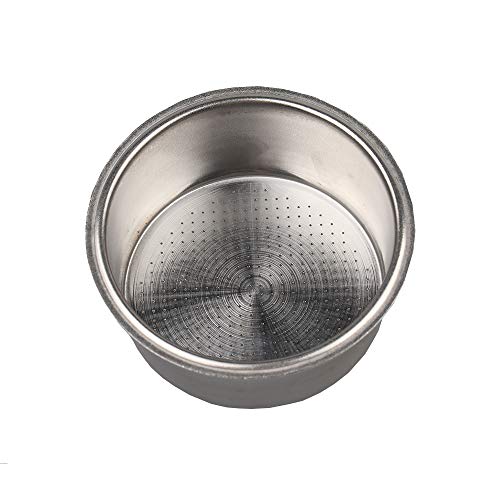Pressurized vs Non-Pressurized Portafilter: The Difference
To start, when looking at both pressurized and non-pressurized portafilters, it’s clear to see that a non-pressurized portafilter has several holes in the basket while a pressurized portafilter has only a singular hole in its basket.
This difference in turn plays into how a pressurized portafilter’s pressure comes from the basket itself while the non-pressurized portafilter’s pressure comes from finely ground and properly tamped espresso.
Because it’s important that espresso has a good extraction process, it’s also important that you understand how to achieve that with the different portafilter types.
Non-pressurized portafilters work better with a finer grind and a good tamp so that you can get the proper amount of pressure needed in the non-pressurized basket. However, a pressurized portafilter works better with coarser grinds so that it can’t block the dual-wall basket, which is how the pressure is achieved in this type of portafilter.
A pressurized portafilter has two screens in its basket, an internal screen that has multiple holes and an external screen that has only one hole. Meanwhile, a non-pressurized portafilter basket has one screen with multiple holes.
Pressurized vs Non-Pressurized Portafilter: Which is Better?
Deciding which portafilter is better is entirely dependent on your situation. If you’re a beginner and just getting started in making your coffee at home, choosing to use a pressurized portafilter is the best choice.
Since you don’t have to worry so much about the grind size and tamp pressure with a pressurized portafilter, it eliminates a lot of the pressure (pun definitely not intended) that comes with a traditional non-pressurized portafilter. This option is also great for those who buy pre-ground coffee to use in their espresso machine since you don’t have to worry about making sure it’s a fine enough grind.
Now, if you have a bit more experience with coffee, you’ll probably want a non-pressurized portafilter. This option allows you to make adjustments yourself so you can control how your espresso ends up, you can even make it better than what a pressurized portafilter can give you.
Of course, you could always go for the slightly more advanced option, the bottomless portafilter. This is another basket type that is only made with the multiple-holed basket so that you can see how the shot is pouring.
A lot of coffee shops love to use this option since it helps you to see what area of preparation for an espresso shot needs fixing. It falls under the category of non-pressurized portafilters, as well.
Education
It may still seem a bit complicated to understand all there is to know about pressurized vs non-pressurized portafilters, so we’ve decided to include a bit more information on the subject.
Controlling the Brewing Process
If you’re particular about how much control you have over the brewing process when it comes to espresso, you might want to purchase a non-pressurized portafilter rather than a pressurized one, since this allows you to not only adjust the pressure, but also the water temperature, tamp pressure, grind size, and more.
Since the slightest adjustment in any of these departments can turn your delicious shot from perfect to bitter, a non-pressurized portafilter takes a little bit more effort and time to work with.
If you’re not interested in these benefits, you might want to pick the much easier-to-use pressurized portafilter, instead. Without having to worry about pressure or other factors, you can easily pull a shot of espresso, even if it may not be the most perfectly extracted one.
Cost Differences
Of course, you have to also keep in mind that with the different portafilters come different prices. Since non-pressurized portafilters need a bit more attention in order to pull a good shot of espresso, they are in turn a bit more costly.
An espresso machine that can provide a group head with a solid ability to regulate the pressure for the portafilter will end up costing a bit more, as well as the need for a grinder so that you can grind fine enough for the non-pressurized basket.
In the end, pressurized portafilters usually come out to be a bit cheaper of an option than non-pressurized portafilters since they eliminate a lot of the steps that come with brewing up espresso.
Frequently Asked Questions
You may have a few more questions regarding pressurized vs non-pressurized portafilters and we’re here to try our best to answer them all.
Should I Use a Pressurized Portafilter?
As we mentioned earlier, it’s best to use a pressurized portafilter if you’re a beginner at making your own coffee. Or, if you prefer to skip all of the extra steps that come with a non-pressurized portafilter, then a pressurized one is a great option for you.
Why Is a Non-Pressurized Portafilter Better?
When it comes to those who are a bit more experienced in the coffee field, non-pressurized portafilters are a better choice. Since they can deliver a tastier espresso shot through the controlling of grind size and tamping pressure, a lot of coffee fanatics prefer this option.
However, if you don’t have a grinder or a good espresso machine, or you just aren’t entirely sure of what you’re doing yet, then it may be best to start out with a pressurized portafilter instead.
Do You Tamp a Pressurized Portafilter?
No, you don’t have to tamp a pressurized portafilter. Since tamping is required to build up pressure, a portafilter that has a valve that builds up its own pressure means no tamping is required.
Sometimes machines will come with a plastic tamper, and it’s usually used to keep the grinds within the basket, not necessarily to provide any pressure.
Which One Will Suit You Best at Home?
This question is entirely up to what level of a home barista you’re at. If you’re brand new, then a pressurized portafilter will be a better option for you. However, if you’ve had you’re fair share of experience with pulling espresso shots, then a non-pressurized portafilter is the way to go.
The choice also depends on whether you also have a grinder available at home, since non-pressurized portafilters require one in order to pull a decent shot.
Pressurized Portafilter vs Non-Pressurized Portafilter: Final Thoughts
Overall, choosing between a pressurized portafilter and a non-pressurized portafilter requires you to know the difference between the two options. As we’ve mentioned a few times, it depends entirely on your experience with making espresso, how easy you want your brewing to be, whether you have a grinder, and the price you’re willing to pay.
For beginners, we recommend trying out a pressurized portafilter before jumping right into learning all the extra steps that come with a non-pressurized portafilter. However, for quality control and for those with a bit more experience, we recommend a non-pressurized portafilter.
Happy Caffeinating!










